Bhooli Bisri Sunehri Yaadein...
When it comes to understanding Bollywood classics, it is about sheer cinematic brilliance, path breaking dialogues, black and white settings, an angry dad smoking a pipe, too much of glycerin outpour and stagnant melodrama. Let us understand the Age. We had not yet seen Madhuri’s dhak dhak, and Karishma’s jalwa. Cinema was developing and Raj Kapoor was the only star we knew of besides Saira Banu, Dev Anand, Mumtaz and Ashok Kumar. Let us retrace some timeless sagas of Bollywood at a glance:
-
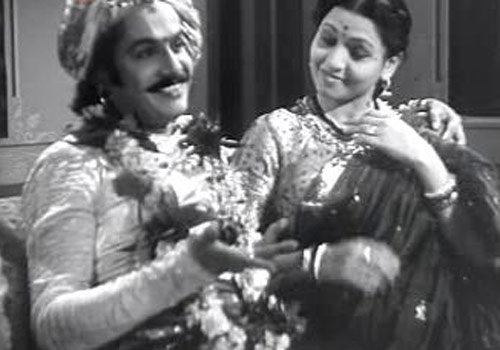
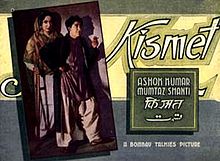 Bombay Talkies’ Kismet
(1943) was a Gyan Mukherjee directed film that was construed as
a thematically bold film and brought out our sadda villain in fashion. Indian films
made before this film generated sympathy, but Kismet evoked apathy in the Indian
audience- a feeling that we were not acquainted with. This cinema shook the audience
with its first unmarried woman character who was shown pregnant. If you are actually
hungry for more, hear this out. This was also the first film ever made that incorporated
the possibility of a double role! Do you have any idea how much money did this film
make way back in the 20th century? Close to 63 crores!!!
Bombay Talkies’ Kismet
(1943) was a Gyan Mukherjee directed film that was construed as
a thematically bold film and brought out our sadda villain in fashion. Indian films
made before this film generated sympathy, but Kismet evoked apathy in the Indian
audience- a feeling that we were not acquainted with. This cinema shook the audience
with its first unmarried woman character who was shown pregnant. If you are actually
hungry for more, hear this out. This was also the first film ever made that incorporated
the possibility of a double role! Do you have any idea how much money did this film
make way back in the 20th century? Close to 63 crores!!! -
Mehboob Khan’s Andaz
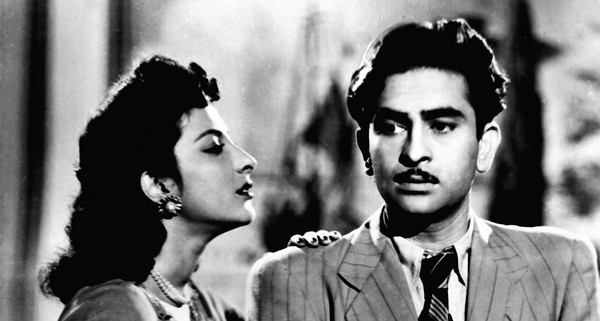
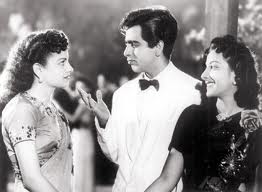 (1949) stars Raj Kapoor
and Dilip Kumar—the two eminent actors of Bollywood who came together
for their only film ever. They formed the perfect love triangle ever with Nargis.
The 20-year old Nargis in this film inevitably reminds us of Audrey Hepburn
in Roman Holiday. A delicately woven love story, the lady is rich and questions the age-old question – if at all a woman can
stay friends male counterparts. The film drips with the nouveau rich depiction where
Nargis is shown to go for horse riding in Jodhpur, this film portray men in total
megalomaniac modes. If you want to feel totally wounded by cupid, here is a must-watch
for you!
(1949) stars Raj Kapoor
and Dilip Kumar—the two eminent actors of Bollywood who came together
for their only film ever. They formed the perfect love triangle ever with Nargis.
The 20-year old Nargis in this film inevitably reminds us of Audrey Hepburn
in Roman Holiday. A delicately woven love story, the lady is rich and questions the age-old question – if at all a woman can
stay friends male counterparts. The film drips with the nouveau rich depiction where
Nargis is shown to go for horse riding in Jodhpur, this film portray men in total
megalomaniac modes. If you want to feel totally wounded by cupid, here is a must-watch
for you! -
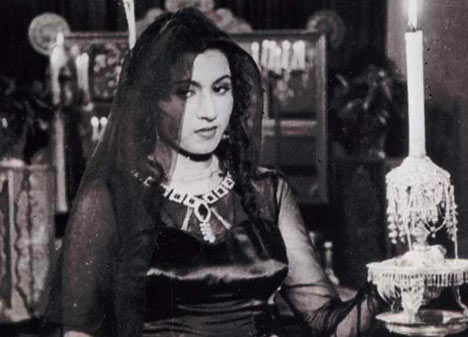 Remember, Ek Teer Chalaa Dil pe Lagaa? Mahal (1949) made Ashok Kumar
and Madhubala the hottest pair of the 20th century. The king of supernatural
suspense that still sends down thrills down one’s spine, this is all about reincarnation.
This film is supposedly said to have put world cinema into motion with this new
concept. The Reincarnation of peter Proud is an influence of Mahal. This is what
Bollywood is all about. It can surprise you in the most unimaginable ways!
Remember, Ek Teer Chalaa Dil pe Lagaa? Mahal (1949) made Ashok Kumar
and Madhubala the hottest pair of the 20th century. The king of supernatural
suspense that still sends down thrills down one’s spine, this is all about reincarnation.
This film is supposedly said to have put world cinema into motion with this new
concept. The Reincarnation of peter Proud is an influence of Mahal. This is what
Bollywood is all about. It can surprise you in the most unimaginable ways!
-
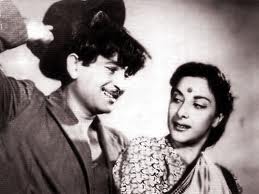 We are talking about an immortal classic here, Awara (1951). This film is
a close cropped view on the black and white era when the Kapoor’s make Bollywood
cinema worth an experience. The plot revolves around the classic good-wins-over-evil
and the evil will never change its ways. Jagga who is convicted by the wealthy judge
Raghunath goes on to kidnap the judge’s wife Leela for revenge rolling the movie
into motion. Raj, her son also turns into a criminal due to unfortunate circumstances
and turns to Jagga as his Guru. The former tries to quit the world of crime but
fails umpteen number of times thereby making the story highly cathartic. Nominated
for the Cannes way back in 1953 and remade into a Turkish film, this film has won
many hearts in the entire Indian subcontinent and abroad in countries such as Africa,
Middle East and Soviet Union!
We are talking about an immortal classic here, Awara (1951). This film is
a close cropped view on the black and white era when the Kapoor’s make Bollywood
cinema worth an experience. The plot revolves around the classic good-wins-over-evil
and the evil will never change its ways. Jagga who is convicted by the wealthy judge
Raghunath goes on to kidnap the judge’s wife Leela for revenge rolling the movie
into motion. Raj, her son also turns into a criminal due to unfortunate circumstances
and turns to Jagga as his Guru. The former tries to quit the world of crime but
fails umpteen number of times thereby making the story highly cathartic. Nominated
for the Cannes way back in 1953 and remade into a Turkish film, this film has won
many hearts in the entire Indian subcontinent and abroad in countries such as Africa,
Middle East and Soviet Union! -
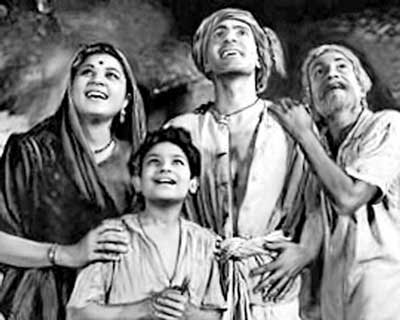 You sure don't wish to get introduced to Bimal Roy’s Do Bigha Zameen
(1953), gone beyond success and gave the cinema culture in India a new turn.
It won the Cannes Award and also won the Filmfare award. Do you know where this
film got its title from? Tagore’s poem – ‘Dui Bigha jomin’. After this, Indian cinema
never remained the same. Aping Vittorio de Sica’s Bicycle Thieves, the plot is set
in a drab village on the verge of famine. Shambhu (Balraj Sahni), the central
protagonist owns two bighas, as goes the title, on which a wealthy constructor wants
to setup a mill to make profit. This land being the only livelihood of Shambhu,
he refuses. Later he ends up losing the legal dispute as well. The movie comes to
a climax when Shambhu returns to his village to see the construction has begun and
they silently walk away from their do bigha zamin.
You sure don't wish to get introduced to Bimal Roy’s Do Bigha Zameen
(1953), gone beyond success and gave the cinema culture in India a new turn.
It won the Cannes Award and also won the Filmfare award. Do you know where this
film got its title from? Tagore’s poem – ‘Dui Bigha jomin’. After this, Indian cinema
never remained the same. Aping Vittorio de Sica’s Bicycle Thieves, the plot is set
in a drab village on the verge of famine. Shambhu (Balraj Sahni), the central
protagonist owns two bighas, as goes the title, on which a wealthy constructor wants
to setup a mill to make profit. This land being the only livelihood of Shambhu,
he refuses. Later he ends up losing the legal dispute as well. The movie comes to
a climax when Shambhu returns to his village to see the construction has begun and
they silently walk away from their do bigha zamin.

 Bombay Talkies’ Kismet
(1943) was a Gyan Mukherjee directed film that was construed as
a thematically bold film and brought out our sadda villain in fashion. Indian films
made before this film generated sympathy, but Kismet evoked apathy in the Indian
audience- a feeling that we were not acquainted with. This cinema shook the audience
with its first unmarried woman character who was shown pregnant. If you are actually
hungry for more, hear this out. This was also the first film ever made that incorporated
the possibility of a double role! Do you have any idea how much money did this film
make way back in the 20th century? Close to 63 crores!!!
Bombay Talkies’ Kismet
(1943) was a Gyan Mukherjee directed film that was construed as
a thematically bold film and brought out our sadda villain in fashion. Indian films
made before this film generated sympathy, but Kismet evoked apathy in the Indian
audience- a feeling that we were not acquainted with. This cinema shook the audience
with its first unmarried woman character who was shown pregnant. If you are actually
hungry for more, hear this out. This was also the first film ever made that incorporated
the possibility of a double role! Do you have any idea how much money did this film
make way back in the 20th century? Close to 63 crores!!!
 (1949) stars Raj Kapoor
and Dilip Kumar—the two eminent actors of Bollywood who came together
for their only film ever. They formed the perfect love triangle ever with Nargis.
The 20-year old Nargis in this film inevitably reminds us of Audrey Hepburn
in Roman Holiday. A delicately woven love story, the lady is rich and questions the age-old question – if at all a woman can
stay friends male counterparts. The film drips with the nouveau rich depiction where
Nargis is shown to go for horse riding in Jodhpur, this film portray men in total
megalomaniac modes. If you want to feel totally wounded by cupid, here is a must-watch
for you!
(1949) stars Raj Kapoor
and Dilip Kumar—the two eminent actors of Bollywood who came together
for their only film ever. They formed the perfect love triangle ever with Nargis.
The 20-year old Nargis in this film inevitably reminds us of Audrey Hepburn
in Roman Holiday. A delicately woven love story, the lady is rich and questions the age-old question – if at all a woman can
stay friends male counterparts. The film drips with the nouveau rich depiction where
Nargis is shown to go for horse riding in Jodhpur, this film portray men in total
megalomaniac modes. If you want to feel totally wounded by cupid, here is a must-watch
for you! Remember, Ek Teer Chalaa Dil pe Lagaa? Mahal (1949) made Ashok Kumar
and Madhubala the hottest pair of the 20th century. The king of supernatural
suspense that still sends down thrills down one’s spine, this is all about reincarnation.
This film is supposedly said to have put world cinema into motion with this new
concept. The Reincarnation of peter Proud is an influence of Mahal. This is what
Bollywood is all about. It can surprise you in the most unimaginable ways!
Remember, Ek Teer Chalaa Dil pe Lagaa? Mahal (1949) made Ashok Kumar
and Madhubala the hottest pair of the 20th century. The king of supernatural
suspense that still sends down thrills down one’s spine, this is all about reincarnation.
This film is supposedly said to have put world cinema into motion with this new
concept. The Reincarnation of peter Proud is an influence of Mahal. This is what
Bollywood is all about. It can surprise you in the most unimaginable ways!
 We are talking about an immortal classic here, Awara (1951). This film is
a close cropped view on the black and white era when the Kapoor’s make Bollywood
cinema worth an experience. The plot revolves around the classic good-wins-over-evil
and the evil will never change its ways. Jagga who is convicted by the wealthy judge
Raghunath goes on to kidnap the judge’s wife Leela for revenge rolling the movie
into motion. Raj, her son also turns into a criminal due to unfortunate circumstances
and turns to Jagga as his Guru. The former tries to quit the world of crime but
fails umpteen number of times thereby making the story highly cathartic. Nominated
for the Cannes way back in 1953 and remade into a Turkish film, this film has won
many hearts in the entire Indian subcontinent and abroad in countries such as Africa,
Middle East and Soviet Union!
We are talking about an immortal classic here, Awara (1951). This film is
a close cropped view on the black and white era when the Kapoor’s make Bollywood
cinema worth an experience. The plot revolves around the classic good-wins-over-evil
and the evil will never change its ways. Jagga who is convicted by the wealthy judge
Raghunath goes on to kidnap the judge’s wife Leela for revenge rolling the movie
into motion. Raj, her son also turns into a criminal due to unfortunate circumstances
and turns to Jagga as his Guru. The former tries to quit the world of crime but
fails umpteen number of times thereby making the story highly cathartic. Nominated
for the Cannes way back in 1953 and remade into a Turkish film, this film has won
many hearts in the entire Indian subcontinent and abroad in countries such as Africa,
Middle East and Soviet Union! You sure don't wish to get introduced to Bimal Roy’s Do Bigha Zameen
(1953), gone beyond success and gave the cinema culture in India a new turn.
It won the Cannes Award and also won the Filmfare award. Do you know where this
film got its title from? Tagore’s poem – ‘Dui Bigha jomin’. After this, Indian cinema
never remained the same. Aping Vittorio de Sica’s Bicycle Thieves, the plot is set
in a drab village on the verge of famine. Shambhu (Balraj Sahni), the central
protagonist owns two bighas, as goes the title, on which a wealthy constructor wants
to setup a mill to make profit. This land being the only livelihood of Shambhu,
he refuses. Later he ends up losing the legal dispute as well. The movie comes to
a climax when Shambhu returns to his village to see the construction has begun and
they silently walk away from their do bigha zamin.
You sure don't wish to get introduced to Bimal Roy’s Do Bigha Zameen
(1953), gone beyond success and gave the cinema culture in India a new turn.
It won the Cannes Award and also won the Filmfare award. Do you know where this
film got its title from? Tagore’s poem – ‘Dui Bigha jomin’. After this, Indian cinema
never remained the same. Aping Vittorio de Sica’s Bicycle Thieves, the plot is set
in a drab village on the verge of famine. Shambhu (Balraj Sahni), the central
protagonist owns two bighas, as goes the title, on which a wealthy constructor wants
to setup a mill to make profit. This land being the only livelihood of Shambhu,
he refuses. Later he ends up losing the legal dispute as well. The movie comes to
a climax when Shambhu returns to his village to see the construction has begun and
they silently walk away from their do bigha zamin.























Comments